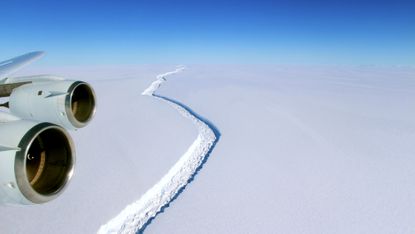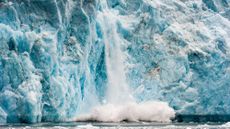Large part of Antarctic ice shelf is due to snap off
Crack has grown 11 miles in just six days

A massive stretch of ice is set to break off from one of Antarctica's largest ice shelves and create the world's biggest iceberg.
The crack in the Larsen C shelf, which has grown slowly for decades, recently started to accelerate. In just six days it has grown by an astonishing 11 miles.
Scientists have been tracking the rift growing along the Larsen C shelf for years. They now say the fracture is within eight miles of the sea and that there is "nothing to stop it fracturing".
Subscribe to The Week
Escape your echo chamber. Get the facts behind the news, plus analysis from multiple perspectives.

Sign up for The Week's Free Newsletters
From our morning news briefing to a weekly Good News Newsletter, get the best of The Week delivered directly to your inbox.
From our morning news briefing to a weekly Good News Newsletter, get the best of The Week delivered directly to your inbox.
Experts are waiting to see whether the process has been affected by climate change, reports Sky News.
At around the same size of the Caribbean nation of Trinidad and Tobago, the fragment will become one of the largest icebergs ever recorded once it breaks off.
The shelf is around 350m thick and is currently located at the edge of Western Antarctica.
Scientists at Project Midas, a UK-based research group studying the shelf, sayt there is very little time left until the fragment separates. The event has far-reaching consequences. It would change the Antarctic landscape dramatically, creating an unstable shelf.
Adrian Luckman, a Project Midas scientist, said: "We have previously shown that the new configuration will be less stable than it was prior to the rift, and that Larsen C may eventually follow the example of its neighbour Larsen B, which disintegrated in 2002 following a similar rift-induced calving event."
While the Larsen C event is believed to be the result of natural geophysical processes, scientists widely accept that climate change was a contributing factor in the disintegration of the Larsen A and Larsen B shelves in 1995 and 2002 respectively.
Create an account with the same email registered to your subscription to unlock access.
Sign up for Today's Best Articles in your inbox
A free daily email with the biggest news stories of the day – and the best features from TheWeek.com
-
 5 sleeper hit cartoons about Trump's struggles to stay awake in court
5 sleeper hit cartoons about Trump's struggles to stay awake in courtCartoons Artists take on courtroom tranquility, war on wokeness, and more
By The Week US Published
-
 The true story of Feud: Capote vs. The Swans
The true story of Feud: Capote vs. The SwansIn depth The writer's fall from grace with his high-flying socialite friends in 1960s Manhattan is captured in a new Disney+ series
By Adrienne Wyper, The Week UK Published
-
 Scottie Scheffler: victory for the 'pre-eminent golfer of this era'
Scottie Scheffler: victory for the 'pre-eminent golfer of this era'Why Everyone's Talking About Masters victory is Scheffler's second in three years
By The Week Staff Published
-
 What is rock flour and how can it help to fight climate change?
What is rock flour and how can it help to fight climate change?The Explainer Glacier dust to the rescue
By Devika Rao, The Week US Published
-
 Arid Gulf states hit with year's worth of rain
Arid Gulf states hit with year's worth of rainSpeed Read The historic flooding in Dubai is tied to climate change
By Peter Weber, The Week US Published
-
 The growing thirst for camel milk
The growing thirst for camel milkUnder the radar Climate change and health-conscious consumers are pushing demand for nutrient-rich product – and the growth of industrialised farming
By Harriet Marsden, The Week UK Published
-
 Why curbing methane emissions is tricky in fight against climate change
Why curbing methane emissions is tricky in fight against climate changeThe Explainer Tackling the second most significant contributor to global warming could have an immediate impact
By Richard Windsor, The Week UK Published
-
 How the EU undermines its climate goals with animal farming subsidies
How the EU undermines its climate goals with animal farming subsidiesUnder the radar Bloc's agricultural policy incentivises carbon-intensive animal farming over growing crops, despite aims to be carbon-neutral
By Harriet Marsden, The Week UK Published
-
 Why are people and elephants fighting in Sri Lanka?
Why are people and elephants fighting in Sri Lanka?Under The Radar Farmers encroaching into elephant habitats has led to deaths on both sides
By Chas Newkey-Burden, The Week UK Published
-
 How climate change is contributing to global unrest
How climate change is contributing to global unrestIn Depth Some experts argue that global warming can be tied to rising levels of violence around the world
By Justin Klawans, The Week US Published
-
 Why last-chance tourism is the latest controversial travel trend
Why last-chance tourism is the latest controversial travel trendThe Explainer Race to visit places threatened by climate change 'before it's too late'
By Austin Chen, The Week UK Published